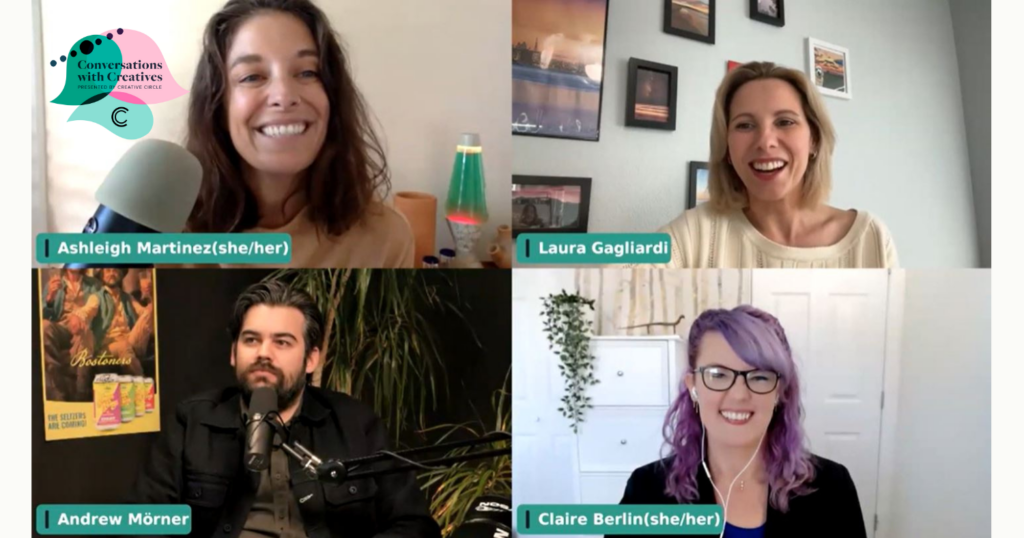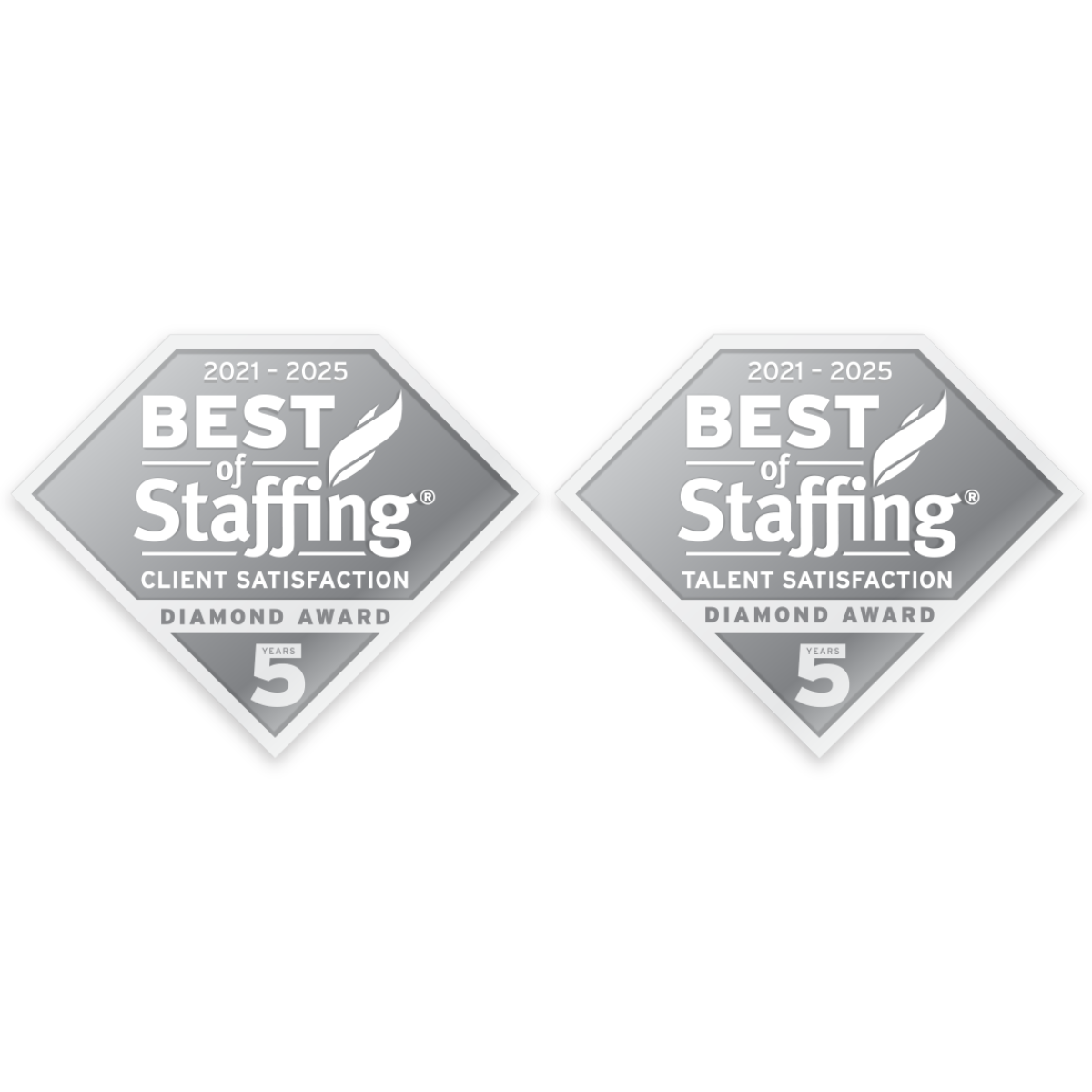Three experts tell us how creatives can best position themselves to thrive in this AI era.
AI has already had a monumental impact on creative work — and its evolution is only accelerating. How can creatives best position themselves to thrive in this AI era? What new opportunities does AI present, and what risks should we all be aware of?
To get our finger on the pulse, we brought in three experts for a panel discussion. Meet Andrew, Claire, and Laura! They’re the first panelists to participate in our Conversations with Creatives series. They sat down with us, in front of hundreds of intrigued minds across North America, to discuss their experience using AI in the creative space.
- Andrew Morner is an “AI-obsessed” Creative Director at Pillar Marketing Corporation, a full-service digital marketing, design, and mar-tech agency based in Los Angeles. He uses AI in every single project that he works on.
- Claire Berlin is currently the Director of Academic Marketing Strategy at Ohio University. Before that, she was working in the tech industry and got her hands on many generative AI tools as they were launching.
- Laura Gagliardi is a freelance content designer, currently on contract as a Conversational Designer and Strategist with Verizon. She uses AI to enhance her services and provide a high-quality experience for the end-user.
Here’s what we covered! Click the links to skip to the associated timestamped spot in our insightful hour-long discussion.
How did you evolve your role into an AI-focused position?
Laura started her freelance career as a copywriter. Her role evolved when she began leveraging her education in psychology to shape how companies and brands communicate with their consumers. She used AI to focus on putting humanity behind the robot’s interactions with users.
How do you use AI for marketing-focused projects?
Claire uses AI as a brainstorming tool and often leans on it to kickstart or refine her creative process.
Laura says AI serves as a catalyst for inspiration — she pulls parts and pieces from the responses it generates and builds out her content from there. “AI enables me to be more efficient; it refines my ideas and inspires me,” says Laura. “It’s a muse!”
How are you using AI as a tool to streamline your projects and processes?
Claire uses AI to make the most of her time! Some examples are:
- Using AI notetaking tools (Zoom and Google Meet) to do the busy work so she can actively listen during meetings with her clients.
- Drafting marketing strategy and frameworks.
How are you using AI in design and creative?
Andrew is using AI to significantly augment his creative process. He uses it for everything from writing email and social media copy to graphic design, researching and auditing organizations, and developing site maps.
“We use it for pretty much every project that we find ourselves working on,” says Andrew. “It’s really augmenting our process in huge ways and it’s becoming the missing piece to a puzzle in a lot of ways.”
He speaks to how “unintuitive” ChatGPT can be and how important descriptive prompts are — it forces him to ask himself “Am I asking it the right question?”. Through trial and error, and a little help from Reddit users, he’s perfected his prompts.
What AI design tools are you using regularly?
Midjourney, Dall-E 3, and Photoshop Generative AI are Andrew’s favorites, but he emphasized how quickly AI evolves and suggested that creatives always keep an eye out for new systems.
How do you use AI as a research tool in marketing strategy?
Claire relies on AI for persona research and learning about unfamiliar audiences. AI systems can outline the things the audience cares about, the language that resonates with them, etc.
“AI is incredibly helpful with persona research! With the proper prompts and guiderails, it can tell you a lot about a specific audience.” says Claire. She’s used it to adapt her content and messaging when targeting less familiar audiences, such as younger generations, c-suite level executives, and medical professionals. She reminds us, however, that it’s not 100% accurate: “It’s a CliffsNotes version and it always needs a second set of eyes.”
How transparent are you with your clients about your use of AI?
Andrew walks his clients through his AI use and process upfront. He makes sure to tell them that it’s a huge value-add to his services because he can build out a campaign calendar in a fraction of the time it would otherwise take (and at a fraction of the cost).
“AI allows us to create more things, at a higher fidelity, in a quicker amount of time,” says Andrew, “…and the outcome is that the client is happier for it.”
What ethical elements should we be mindful of when using this technology?
Quality checking the content that AI is generating for you is essential. Andrew says, “You must be intentional with your use of AI. A quick way to get let go of your job is to submit something that’s completely AI generated and not check it once.”
“Hallucinations are huge problem with AI; it will make up information and be very confident about it,” he adds. Andrew emphasizes that it’s important for AI to not replace the creative thought process. Instead, it should operate like an assistant, and you should always double check the work.
Claire admits that “AI can be scary.” She says, “anything that you input into AI can be spit out for any other user and that’s a little concerning.”
Digital hygiene is critical, our panelists warned. “OpenAI is using everything that’s currently online and anything that’s being fed to it as training data for future instances. Anything that AI knows comes from things that exist,” says Andrew. “It’s only as good as the training data; stay mindful of that.”
Learn More
Our panelists covered many other burning AI questions, including “How do you expect the creative industry to evolve as AI becomes more prevalent”? and ”What tips do you have to help creatives expand their knowledge on AI?”. If you find these conversations intriguing and you’re left wanting more, watch the full discussion from the start and don’t forget to share your thoughts in the comments. Also, subscribe to our newsletter to stay tuned for future installments of Conversations with Creatives!




